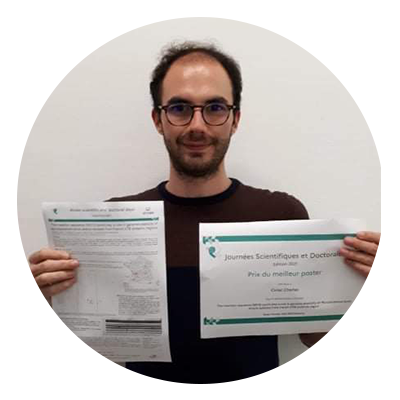"Why does bovine tuberculosis persist in some French regions but not others?” – Portrait of Ciriac Charles, PhD student
Every year, ANSES organises discussion meetings on ongoing and recently completed research work, in order to encourage interactions between scientific teams. At these meetings, the PhD students hosted at the Agency present their theses. Ciriac Charles received the award for best poster by an ANSES doctoral student in 2021. Discover his background and research work.

Can you tell us about your background?
I earned my Bachelor and Master degrees at the Faculty of Fundamental and Applied Sciences of the University of Poitiers, before arriving in Paris for the final year of my Master degree for a work-study opportunity with the Eau de Paris laboratory. I then started my thesis on bovine tuberculosis at ANSES's Laboratory for Animal Health in Maisons-Alfort, under the joint supervision of Maria Laura Boschiroli and Franck Biet from the INRAE. This thesis is co-funded by ANSES and the PEMbo project (From genotype to phenotype: patho-evolution of Mycobacterium bovis French strains) within the One Health European Joint Programme.
What is your thesis about?
The topic of my thesis is the characterisation of French Mycobacterium bovis (M. bovis) strains responsible for bovine tuberculosis outbreaks. This disease, whose main host is cattle, can also be transmitted to humans. It has a major economic impact, especially because it limits the trade of animals. Since 2001, following a control and eradication campaign initiated in France in the 1960s, the country has been free of bovine tuberculosis. However, this status has been threatened in the past few years by a slight but constant increase in the number of outbreaks in cattle. This may be partly due to the occurrence of the disease in wildlife (badgers, wild boar, etc.). French bovine tuberculosis outbreaks are currently highly localised. They are caused by strains with exclusive, specific genotypes in certain regions. The question is why these genotypes have persisted in these regions, unlike in other regions where tuberculosis used to be established but seems to have been eradicated, leaving them free of the disease for some years now.
To answer this question, we want to obtain new reference genomes of strains representative of the history of bovine tuberculosis in France, especially those affecting the regions that have been most heavily impacted by the disease over the past few years. Obtaining whole genomes could help explain the epidemiological success of certain genotypes, by identifying modifications in specific genes or regions of importance involved in the virulence or persistence of the bacterium.
Our study also aims to more precisely define M. bovis groups to understand their evolution in France. Moreover, we are seeking to improve the monitoring and modelling of transmission dynamics by undertaking genomic epidemiology studies in areas where conventional genotyping methods are unable to distinguish between similar strains.
What was the most difficult aspect of presenting your thesis on a poster?
The most difficult aspect was selecting the information I wanted to present. I would have liked to include more data, but with this type of exercise, you have to be clear and concise to make an impact and hold the audience’s attention.
Do you have any advice for future PhD students taking part in this exercise?
I would advise future participants to try to tell a “story” when presenting their poster. It should be easy to read and the information should flow in a way that is logical so as to accompany the reader.